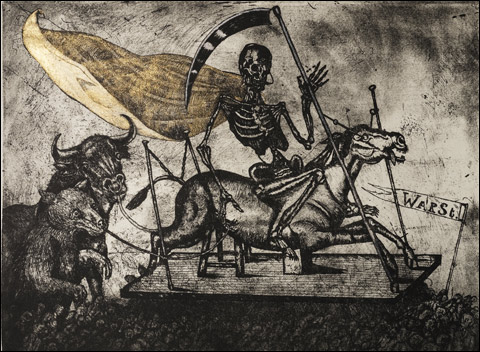
WAR STREET: Stand back from Sue Coe’s drawings to avoid getting singed. |
“William Kentridge: Ambivalent Affinities” and “Projects” | Massachusetts College of Art and Design Galleries, 621 Huntington Ave, Boston | Through December 11 “Sue Coe: The Tragedies of War” | Art Institute of Boston, 700 Beacon St, Boston | Through October 24 “American Letterpress: The Art of Hatch Show Print” | Boston University Art Gallery, 855 Comm Ave, Boston | Through October 31 SLIDESHOW:Kentridge at MassArt. SLIDESHOW:Hatch Show Print at Boston University. |
South African artist William Kentridge is often hailed for providing "a vivid history of apartheid and its legacy," as
Time said when it named him one of the 100 most influential persons of 2009. He was born in 1955 in Johannesburg, where he still makes his home, the child of prominent anti-apartheid lawyers. The violence of institutionalized racial oppression is the backdrop of the poetic, dreamlike, melancholy, hand-drawn animated short films that established his reputation in the 1990s. But when you watch them in MassArt's exhibits "Ambivalent Affinities" (older work, organized by the University of Illinois's Krannert Art Museum) and "Projects" (newer work, organized by MassArt), they can seem to have as much to do with civil rights in South Africa as
Gone with the Wind has to do with slavery.
Kentridge's recurring main characters are two stout, middle-aged white fellows — both cockeyed self-portraits. Soho Eckstein is a sketchy developer in a pinstripe suit. Felix Teitlebaum is an artist lusting after Eckstein's wife. Surreal touches (Teitlebaum is always naked, as if in an anxiety dream) keep them from reading as complete stereotypes.
Eckstein buys "half of Johannesburg" while Teitlebaum licks his wife's hand. Or Eckstein, as "civic benefactor," unveils a monument of a black laborer. Or Eckstein's easy life is juxtaposed with that of black men crammed into bunks. Black characters are rarely individualized; they appear as anonymous clusters of protesters haunting the edges. Kentridge focuses on how white guys take advantage of the situation, on white anxiety, or maybe just on white guys feeling sorry for themselves.
The exception is the nine-minute "Felix in Exile" (1993), likely his finest film. It's a surreal allegory in which a black woman surveys a bleak landscape, apparently in preparation for building. See it as an allegory for rebuilding South Africa after apartheid. Construction stakes appear around black men, who lie on the ground bleeding. The bodies disappear, replaced by a pool of some kind, a billboard. Teitlebaum, naked in an empty bedroom, opens a suitcase full of drawings and stares at himself in the mirror. His reflection becomes the woman. His sink overflows, flooding the room. Man and woman embrace. The woman gazes through a sextant at black protesters. A gunshot sends her to the ground, bleeding. Her body disappears, replaced by a pond in which Teitlebaum wades.
Kentridge made the film just before South Africa's first democratic elections, in which Nelson Mandela was chosen president. He isn't a great draftsman (the lithographs, etchings, and engravings in the show often feel ham-handed, inert), but here his grubby animation style — charcoal drawings that he sketches and erases, leaving behind ghost images, then redraws, erases, draws some more, and so on — suggests how the crimes of the past haunt and soil the present.